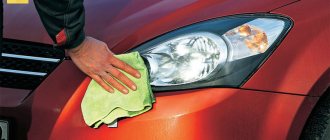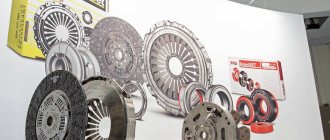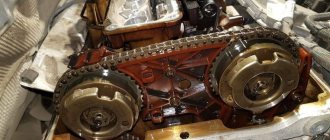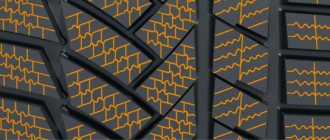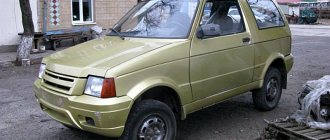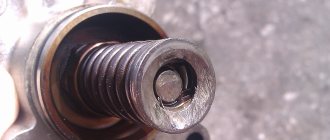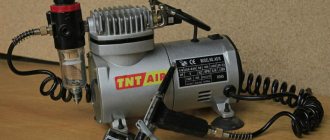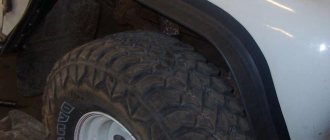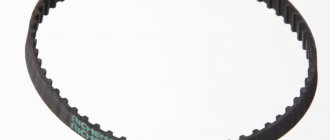Advantages and features of tire repair with a harness
Experts recommend that drivers buy and carry a tire repair service kit with them in their car. It will allow you to fix a puncture with your own hands, quite quickly, somewhere on a deserted highway. The kit is inexpensive, on average 115 – 650 rubles. As a rule, all its elements are packed in a case or suitcase. The set does not take up much space; it can be kept in the glove box or put in the trunk.
What kind of puncture can a tourniquet handle? It will easily seal a 3-6mm hole. As for cuts and tears of 10 mm or more, this is already serious damage for which this repair kit is useless. They also cannot repair punctured tube tires. The harness is also unsuccessful during partial disassembly, when the tire comes off the hump after hitting a road pothole.
Preventive tire sealant
About the wheel repair kit
Even if you are able to change a flat tire faster than a soldier can completely disassemble and clean a machine gun, and you always have a spare tire in the trunk, ready for use, it is better to avoid the need to take up the jack altogether. Therefore, regardless of whether your car is old or new, with intact or retreaded tires, in order to prevent punctures, it is a good idea to purchase tire sealant in advance. This is better than thinking about how to change a tire faster.
The composition is poured through the nipple into the cavity, where it is distributed due to centrifugal force. Moreover, depending on the presence or absence of a camera, it behaves differently. In the first case, the sealant spreads in the air cushion between the inner tread layer and the cylinder, simultaneously protecting the load-bearing part of the tire - the cord, regardless of whether it is made of polymer or metal. In addition, tube wheels tend to heat up due to the same air cushion around the cylinder, and the sealant, due to its low boiling point, evaporates and cools the treads. In the tubeless version, the composition is simply distributed over the inner sealed surface.
Types of tourniquets - what are they?
The designs and structures of the bundles are different. They differ in technical characteristics and cost. You can buy them separately, for example, if your set runs out of elastic bands. The most popular are 3 types of harnesses:
- Rubber. This is a mixture of synthetic and natural rubber, which melts into a soft mass at T+50C°. That is, it is nothing more than raw rubber. This type should be used carefully, as the material breaks easily.
- Cordovy. The rubber mixture also consists of natural and synthetic rubber resins. But the harness contains viscose cord threads for additional puncture reinforcement. This product is more reliable, so it allows you to repair not only passenger tires, but also truck tires.
- Nylon. The structure of the rubber mixture contains synthetic threads. The product is highly reliable and expensive.
All types of harnesses are available for free sale. In addition to different types, products can have different diameters of 3 – 4.5 – 6 mm. It is recommended to buy several pieces of each, since the puncture holes vary.
What is the difference between tire repair sealant?
Let’s say you didn’t bother with the timely purchase of a preventative composition, but in the glove compartment you have an aerosol that was included with the car and should replace the missing spare tire. The absence of a wheel in the trunk is unnerving, and then the “long-awaited” puncture happens. We read the instructions on the can and find out that repair sealant for tires needs to be injected when the tire is flat. Well, after a few minutes it becomes just like that, all that remains is to try the composition.
If you have a really high-quality express repair product, events will unfold as follows. You connect the can to the nipple (after shaking it), directly or through a short adapter, and press the valve. The wheel begins to noticeably round, raising the body of the car; foam or a different consistency of the composition may well begin to emerge from the puncture.
Having measured the atmosphere in the tread, we bleed or inflate the wheel to the desired condition and drive off. After a few kilometers, it is recommended to slow down and measure the tire pressure again, since some compounds maintain activity for a long time.
For example, the optimal pressure is 2 atmospheres, after filling the compound the tire was inflated to 2.4. We bled off the excess air, drove off, took measurements after a few kilometers, and all this time the wheel continued to inflate and the pressure gauge showed 2.2. We need to play it off again. There are compounds that just prevent the tires from deflating, or require regular inflation, but this is far from the best choice.
Be careful, some aerosol sealants contain flammable gases, and when using them it is strictly not recommended to inflate the wheel with air
What is included
Repair kits vary in content. Some with a minimal set of elements, others with a wider range. The latter are mainly purchased by representatives of tire workshops. The standard kit for self-repair includes:
- Drill - a screw or straight rasp with a handle, for preparing a hole for repair.
- An awl is a thick steel needle for placing a tourniquet at the puncture site.
- Glue is a special quick-drying composition.
- 30-40 strands of raw rubber.
Experts do not recommend using a screw rasp. During its operation, the cord threads are damaged. It is recommended to choose a set with a straight rod, usually 4-sided.
Preventative or repair
Tires are filled with preventative sealants before they are punctured. The centrifugal force that occurs while the car is moving contributes to its uniform distribution over the entire surface. These types of sealant are used to protect steel and polymer cords from possible corrosion, which often occurs as a result of damage to rubber and the ingress of moisture and air.
In tires treated with sealant on the inside, oxidation, which has a detrimental effect on the rubber composition, is significantly slowed down. Having a unique chemical composition, the sealant fills the pores and areas of delamination of the tire, smoothing them out. And if the rubber overheats, it effectively cools it.
Repair sealants are mainly sold in cans, in the form of aerosols. They are designed to maintain a minimum pressure inside the tire, which will be enough to get to the tire shop.
How to fix a puncture with a tourniquet yourself
A puncture is an unexpected circumstance. While you have not yet punctured a tire on the road, it is recommended to undergo training, i.e., repair the tire with a tourniquet yourself. To do this, you can find an old wheel in the garage that will do for practice. Inflate the tire. Make a puncture (for example, tighten a screw). Now follow the instructions:
- Prepare the tool, remove 1 tourniquet.
- Take a rasp and drill out the hole well.
- Thread a rubber cord into the eye of the awl.
- Lubricate the harness and the working hole with glue (the deeper the better).
- Insert the awl into the puncture and pull it out quickly.
- Cut the two protruding ends flush with the tread.
- Inflate the tire and check the tightness of the repair area using soap or clean water.
If you are repairing a suspended wheel on the road, be sure to put the car on the handbrake. The shock may cause the car to fall off the jack.
Without removing the wheels
If the puncture is on the front wheel, then the work can be done without removing it. True, you will have to jack up the car in this place, having first moved the gearbox lever to neutral mode. Having done this, turn the front wheels to the side until they stop.
And we do the same work: by rotating the wheel, we apply a soap solution to it. If a puncture is detected, we clean the damaged area with a file, insert a mandrel with a tourniquet of the required size there and pull it out, after which we trim the ends of the tourniquet. After 5-10 minutes, lower the car, remove the jack and inflate the tire. Problem solved.
It is possible to fix a punctured wheel yourself, without resorting to the help of a special workshop. The main thing is to take into account the characteristics of the tire and correctly assess the degree of its damage.
- How to disassemble a wheel yourself, see (and read) here.
Send all questions and suggestions regarding the “Technical Environment” series of issues to: ..
Other episodes of “Technical Environment” are available in our special project, as well as on our YouTube channel.
Repairing a puncture using a tourniquet - simple instructions
Do I need to go to a tire repair shop?
Many car owners turn to tire shops, where service workers seal punctures with tourniquets. Experts say this is wrong from a professional point of view. Why? Because the plug from the harness may fly out or dry out over time. The tire is depressurized. This restoration is considered temporary. To fix a puncture professionally, you need to use fungus-type patches (anchor). This element will seal the hole cavity, and its round patch will reliably protect the rod from falling out.
Disadvantages of tubeless tires
The disadvantages include the fact that with a strong impact there is a chance of the tubeless tire depressurizing. Without the special skills and tools that every tire shop master owns, it will be impossible to eliminate such a problem. If you do not have a compressor on hand that is equipped with a “pneumatic shock”, all attempts to inflate the tire will be in vain. The best option is to install a spare tire or a spare tire.
Summary
Car owners can independently repair a tubeless tire after a puncture. In some cases, it will not be necessary to remove the wheel from the car. If the damage is on the front end, just turn the steering wheel and find the air leak. For restoration, it is better to use cord bundles, since they have a reinforced structure. It is not recommended to drive for a long time on a retreaded tire, as this removal of a puncture is considered temporary. It is necessary to contact a tire service to install an anchor (fungus).
Sealing
Once the puncture is found, you can use a special sealant, sold in almost every car dealership. Do not rush to remove the foreign object immediately. The sealant must be used in the following sequence:
- Remove the cap from the valve.
- Connect the can.
- Pump sealant through the valve into the tire.
- Remove the object that caused the puncture.
- Inflate the tire.
It is worth noting that the pressure inside the tire must be more than one atmosphere, otherwise the sealant will not help you. Before manipulation, the wheel must be inflated.
Please remember that this type of repair is temporary. Vulcanization with sealant will only last for a hundred kilometers, but this is enough for you to get to the workshop. In this case, you will also have to comply with the speed limit, moving at a speed of no more than 60 km/h. If you drive faster, the sealant may crumble and the wheel will begin to lose pressure again.
Remove from the wheel
It seems that everything is clear, you need to pull this “piece of metal” out of the wheel. However, this is not always easy to do.
If you are hoping that you can just pull it out with your fingers and it will come out, this is not so.
For example, if there is a “screw” sitting on it, then it has edges, and it is VERY not easy to pull it out. And, as usually happens, the top cap is worn off.
The most important thing here is to stock up on the necessary tools; I advise you to take metal cutters, they have a thin “nose” with which you can pick up any nail.
Next, simply pull it out with a sharp movement, and immediately you need to clean the hole
How does a tire work?
The design of a modern tire is a rather complex system, within which there are two types of strength frame:
- Metal frame - made of the finest metal wire threads;
- Frame made of durable nylon threads.
There are 2 types of car tire products:
- radial - the cord threads do not intersect, they are located transversely from one side to the other;
- diagonal - cord threads are located diagonally from one side to the other, crossing in layers.
During the production of tires, the power frame made of metal and nylon is filled with a layer of rubber, which gives strength to the structure. The cord made of wire and threads is firmly held by a rubber layer, and the wheel can withstand heavy loads without bursting.
Why is a tire cut dangerous?
When cut on the side, the wires and cords are torn or cut, and the strength of the entire wheel is lost. Even when the cut is sealed, these threads are not restored. And any obstacle in the form of a hole or curb can lead to dire consequences. The wheel will simply burst from the load and the car will lose control.
A side puncture is not so dangerous, and after a quality repair it is quite possible to use such a wheel.
